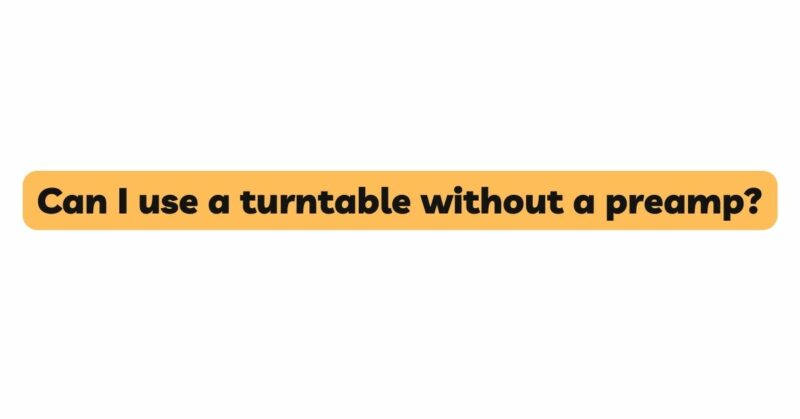The resurgence of vinyl records has ushered in a renewed appreciation for analog sound quality, sparking interest in turntables as the gateway to an immersive music experience. As individuals embark on their vinyl journey, questions arise about the necessity of using a preamp with a turntable. Can a turntable be used without a preamp? This article delves into the intricacies of using a turntable without a preamp, exploring the role of preamps in the audio chain, the scenarios in which preamps are necessary, and the benefits and considerations of bypassing preamps for a more direct sound path.
The Role of Preamps in Audio Playback
Before delving into the use of turntables without preamps, it’s important to understand the role of preamps in the audio chain. Preamps, short for preamplifiers, play a crucial role in amplifying the low-level signals produced by audio sources before they are sent to power amplifiers and speakers. They boost the signal to a level that is suitable for driving speakers and producing audible sound. In the context of vinyl playback, preamps also include the RIAA equalization curve, which corrects the frequency response of vinyl records to ensure accurate sound reproduction.
Traditional Turntable Setup with Preamp
In a traditional turntable setup, a built-in or external preamp is used to amplify the low-level signals generated by the turntable’s cartridge. The amplified signals are then sent to the power amplifier and speakers, resulting in audible sound. This setup ensures that the signal from the turntable is properly boosted and equalized before being played back.
Using a Turntable Without a Preamp
Contrary to common belief, it is indeed possible to use a turntable without a preamp. However, there are important factors to consider before proceeding with this setup. Turntables without preamps, often referred to as “phono stage” or “phono input,” require an additional step in the audio chain: connecting the turntable directly to an external phono preamp.
Benefits of Using a Turntable Without a Preamp
- Customization of Sound: Using a turntable without a preamp allows for more control over the sound characteristics. Enthusiasts can choose external phono preamps that match their preferred sonic profile, resulting in a more personalized and tailored audio experience.
- Audiophile-Grade Sound: Bypassing the built-in preamp can lead to a more direct and transparent sound path. Audiophiles seeking the highest level of sound quality often prefer this setup for capturing the finest nuances and details in the music.
- Upgradability: Owning a turntable without a preamp provides room for upgrades in the form of external phono preamps. Audiophiles can gradually enhance their setup by investing in high-quality preamps, leading to incremental improvements in sound quality.
Considerations When Using a Turntable Without a Preamp
- External Phono Preamp: When using a turntable without a built-in preamp, an external phono preamp is required. This device amplifies the signal from the cartridge and applies the RIAA equalization curve. It’s essential to choose a phono preamp that matches your preferences and budget.
- Cartridge Compatibility: Ensure that the cartridge on your turntable is compatible with the external phono preamp you choose. Different cartridges have varying output levels and impedance requirements.
- Grounding: Some turntables and phono preamps require grounding to reduce unwanted hum and noise. Make sure you follow proper grounding procedures to achieve optimal sound quality.
- Signal Path Quality: While bypassing the built-in preamp can lead to improved sound quality, the overall signal path quality depends on the components used, including the quality of the external phono preamp and other audio equipment in the chain.
Scenarios When Preamps are Necessary
- Built-In Phono Preamp: Some turntables come equipped with a built-in preamp. In this case, using an external phono preamp is optional, and the turntable can be connected directly to a receiver or amplifier with a standard line-level input.
- Phono Inputs on Receivers/Amplifiers: Some receivers and amplifiers feature dedicated phono inputs with built-in preamps. If your audio equipment has a phono input, you can connect the turntable directly to this input.
- Specialized Phono Stages: High-end audio systems may include specialized phono stages that offer advanced equalization options and superior amplification. These setups require a deeper understanding of audio components and signal path optimization.
Conclusion
Using a turntable without a preamp is not only possible but also offers audiophiles and music enthusiasts a unique opportunity to customize their sound experience. By bypassing built-in preamps and opting for external phono preamps, users can achieve a more direct and transparent signal path, resulting in nuanced and unadulterated sound reproduction.
Before setting up a turntable without a preamp, it’s crucial to consider factors such as cartridge compatibility, grounding, and the quality of the external phono preamp. Additionally, it’s important to acknowledge that using a turntable without a preamp is just one facet of the intricate world of analog audio setup, where careful consideration and experimentation play key roles in achieving optimal sound quality.
Ultimately, the decision to use a turntable without a preamp should align with your preferences, audiophile aspirations, and the desire to curate a personalized sound experience that captures the true essence of vinyl playback.


